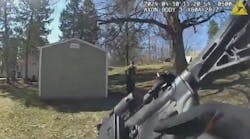In Southern California in October 2007, hundreds of square miles in seven counties were consumed and scorched by scores of brush fires, their flames fueled by high desert winds and hot temperatures. California authorities said the blazes, raging from the Simi Valley northwest of Los Angeles through San Diego County to the Mexican border, were responsible for several deaths. The fires consumed well over 1,400 homes and commercial structures, and threatened tens of thousands of others. As many as 500,000 people were estimated to have evacuated and thousands more were ordered to move, making the evacuation effort roughly half the size of that from the New Orleans area after Hurricane Katrina.
Aerial Firefighting
The United States Forest Service is the largest user of aerial firefighting aircraft. They deploy a variety of aircraft in order to fight wildfires. The range of aircraft includes smaller helicopters to large DC-10 aircraft. On a local level, some police agencies use their aircraft to fight small wildfires. These small wildfires are not confined to rural areas. The New York City Police Department Aviation Unit (NYPD) conducts approximately 25 aerial firefighting operations a year within the borders of the City of New York.
The Mission
Aerial firefighting missions can certainly be considered high risk. Not only does the flight crew have to contend with the usual safety of flight issues, they now have to fly fairly low, often very close to smoke and flying debris. Teamwork is essential for the safe and effective completion of these missions. When an aircraft is called to a scene to assist with aerial firefighting operations, there are many considerations for the flight crew. Where exactly do fire ground commanders want the water drops? Are there any persons in the drop area? Considering that a load of water can weigh up to 1500 lbs, the danger to persons or property on the ground becomes obvious. What are the wind conditions? In short, the mission becomes a complex consideration of risk vs. benefit. The missions are not carried out lightly.
The flight crew normally receives a ground briefing from fire commanders or receives the information in-flight. After conducting several reconnaissance runs, noting the winds, obstructions and possible sources of water, the flight crew determines if the mission can be conducted safely. Possible sources of water include the ocean, lakes, ponds, rivers, swimming pools and water pumped from ground fire vehicles. Helicopters may be fitted with tanks or carry buckets. Tanks are filled using a long hose that is dipped into the water source, while buckets are usually filled by submerging in lakes, rivers, reservoirs, or portable tanks. The most popular of the buckets is the flexible Bambi Bucket.
Often times, a "command and control" aircraft is used to help coordinate and control firefighting operations. In the incidents near navigable waterways, boats may be put in place to secure the water scoop area. As the helicopter approaches a water source, the crew chief keeps a sharp eye out for obstacles. If the bucket gets entangled with an object on the ground, the pilot has seconds to shear the cable and drop the bucket, or face certain disaster. The bucket is submerged and filled and the helicopter begins to lift the load. In most cases, the aircraft is pushed to the limitations of the machine and pilots need to be careful to keep all operating parameters within normal limits. As the aircraft flies to the target location, the load is watched carefully for stability. If the load begins to pendulum, it must be controlled or dropped as excessive swinging could cause havoc with pilot's ability to control the aircraft. Once the approach is commenced, the pilot is careful to avoid any flying debris and smoke. The run is commenced and at the appropriate time, the water is dropped on the fire. The water often contains fire retardant to help contain the fire. After the drop, the effectiveness of the drop is evaluated. The weather conditions can blow water away from the fire line and adjustments must be made. The whole process is then repeated. The workload for the pilot is extreme and missions are often long and taxing. Crew resource management is vital, and the danger of fatigue is high.
The SCUBA diver
There is an urban legend that has been around since at least 1987, in which it is reported that the charred remains of a SCUBA diver were found in a tree, reportedly after he was scooped up by an aerial firefighting aircraft. In some cases, it is reported to be a fisherman. The story is dramatic and certainly has the "wow" factor, but it is absolutely false. The odds of a diver or fisherman being in the water scoop area and not being seen is extremely remote. The technology of taking on water simply would not permit an object that big to be taken into the tank. The only injury every reported by a non-participant in aerial firefighting operations was to a swimmer that was allowed to watch an aerial water scoop too closely. Apparently eddies created as the water was scooped and the aircraft departed and knocked the swimmer down. So, continue to dive and fish without fear! No aerial firefighting aircraft is coming to take you away.
The Challenge
Oftentimes, the best way to fight a brush fire is with aircraft. Brush fires are often hard to reach by ground units even in urban areas, because they are contained within a field of dense brush or the fire ground is in a swampy area making driving a truck into the area all but impossible. These missions are challenging and complex, yet most aviators enjoy flying them. Bombs away!


